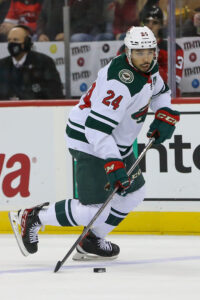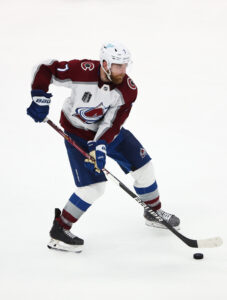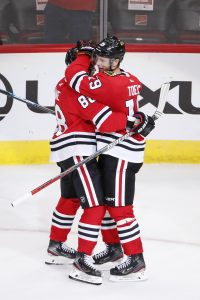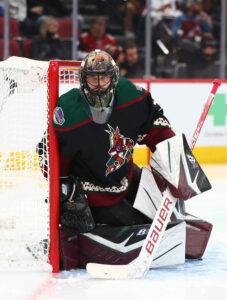Welcome to PHR’s Big Hype Prospects series. Like the MLB Trade Rumors series of the same name, we’ll be taking a regular look at the performances of top prospects from across the hockey world. We’ll look at drafted prospects who are rising, others who are struggling, and prospects for the upcoming draft who are notable.
Four Big Hype Prospects
Fabian Lysell, RW, Boston Bruins (Providence, AHL)
7 GP 2G 7A 9pts
The consequence of the Bruins organization’s relentless pursuit of their second Stanley Cup victory since 2011 is that the team has been left with precious few prospects who can be confidently projected as future impact players, meaning players who fill top-six roles in a forward corps or a top-four role on defense. Winning is always the first priority, so there are few Bruins fans who would reasonably complain about the level of success the team has experienced in the past decade, but that still leaves the franchise in an unclear long-term position.
Lysell, the team’s first-round pick in 2021, has performed so well early this season that he seems to be cementing himself as far and away the Bruins’ most talented prospect. After a 2021-22 campaign in the WHL that was strong, (but maybe not the above-and-beyond dominant type of season that someone such as Dallas Stars prospect Logan Stankoven had) most believed that the AHL would serve as the first true test of Lysell’s young career. Playing against men at an elite professional level can be extremely challenging for many prospects, and quite a few struggle to translate their junior scoring numbers to the pro game, where generating offense can require a different approach.
Lysell has not struggled whatsoever. Playing next to a creative offensive dynamo in Georgii Merkulov and a capable veteran AHL scorer in Vinni Lettieri, Lysell has burst out the gates with nine points in his first seven games. He has shown an advanced ability to deceive defenders and utilize his blazing speed in order to create time and space with the puck. He looks in line to have a big year in Providence, and if he keeps this up it’ll be difficult to imagine him skating anywhere else but on one of the Bruins’ scoring lines next season.
Lane Hutson, LHD, Montreal Canadiens (Boston University, NCAA)
7 GP 3G 5A 8pts
Despite a draft year where he was arguably the best, most dynamic defenseman in the U.S. National Team Development Program, Hutson fell all the way to the back of the 2022 draft’s second round, where he was snagged by the Montreal Canadiens.
Why? Because there aren’t many defensemen in the NHL who stand under five-foot-ten, and Hutson is measured between five-feet-eight and five-feet-nine inches tall. Hutson’s diminutive stature and lack of elite separation skating ability pushed him down NHL draft boards, and some believed that Hutson would not be able to remain an impact defenseman at a more challenging and physically demanding level of hockey.
So far, Hutson has aced that test. With eight points in seven games, Hutson has led the Terriers to an 11th-place ranking in the most recent ranking poll. He has been the same dynamic, pace-pushing offensive generator out of the back end that he was at the USNTDP, and his effort level on defense has not waned. He was recently named the Hockey East Defender of the Month, and could make teams who passed on him sweat if he continues to excel in his first collegiate campaign.
Akil Thomas, C, Los Angeles Kings (Ontario, AHL)
7GP 4G 2A 6pts
As mentioned in Lysell’s section, there are some prospects who score exceedingly well at the junior level and then have trouble translating those numbers into production as a professional. For the past two seasons, former OHL star Akil Thomas looked like one of those players.
In his rookie AHL campaign, Thomas showed some promise, scoring 26 points in 40 games, but there were still some issues in his game that needed to be worked out. Thomas underwent double shoulder surgery and struggled immensely upon his return. He scored just 13 points in 40 games, and as a 22-year-old his prospect stock seemed to have declined sharply since his days as an elite junior player.
This season, Thomas seems to be repairing his standing in a Kings prospect pool that looks highly competitive. Playing on a line with fellow 2018 draftees Aidan Dudas and Tyler Madden, Thomas will be a player to watch this season to see if he has sorted out how to be an impact offensive player as a professional. While the Kings have many other prospects vying for NHL call-ups, don’t be surprised if Thomas finds a way to make his NHL debut this season if he can keep up this level of scoring.
Justin Robidas, C/RW, Carolina Hurricanes (Val d’Or, QMJHL)
12 GP 9G 13A 22pts
Similar to Hutson, Robidas is a prospect whose physical shortcomings cost him in the draft process. After a point-per-game season in the QMJHL, Robidas was drafted in the fifth round of the 2021 draft, 147th overall. Robidas’ speed, motor, and overall work ethic have been his best traits, but his five-foot-eight height is something that gives many evaluators pause when considering his pro projection. Since his draft day, though, Robidas has far outperformed his fifth-round billing.
He was named the captain of the Foreurs last season and impressed with a 30-goal, 82-point campaign. So far this year, Robidas has picked up where he left off. Robidas has scored nine goals and 22 points in just 12 contests, and he looks likely to finish among the top scorers in the QMJHL.
Sure, Robidas’ offensive game can often lack a deceptive or manipulative element to it, meaning he might struggle to be an impact scorer as a professional. Still, Robidas’ development into a junior league star gives more confidence to his projection as a potential bottom-six forward who endears himself to coaches and fans alike with his work ethic, leadership, and tantalizing speed.
A Look to the Top of the 2023 Draft
Regina Pats forward Connor Bedard has attracted most of the attention when it comes to next year’s NHL draft, and for good reason. Bedard is arguably the most talented draft prospect since Connor McDavid was an Erie Otter, and Bedard’s play has lived up to the hype so far this season. But the attention paid to Bedard shouldn’t distract from the fact that the top end of this draft looks stacked in terms of raw talent.
Take Adam Fantilli, a forward now playing for the Michigan Wolverines. Before this season, Fantilli was in the conversation as the second, third, or fourth-best prospect in the draft according to most outlets.
Now, Fantilli has begun the year scoring at a historic pace and has firmly seized the mantle of “best prospect not named Bedard” in this year’s class. On a Wolverines team loaded with top prospects, Fantilli has scored 18 points in just eight games. He’s been scoring at a pace reminiscent of Jack Eichel’s 71-point draft year, and could end up like Eichel as a number-one caliber talent who goes number-two behind a once-in-a-generation star.
Looking beyond Fantilli, there are some other prospects who are surging in the early part of this season. Swedish center Leo Carlsson has burst out the gates early on this year, scoring 11 points in 15 SHL games for Orebro. That scoring pace is at the moment higher than the legendary Henrik Sedin’s 34-point draft campaign all the way back in 1998-99. Carlsson’s prospect profile would land him in the conversation for the number-one pick in most draft years, but this year he may not even be selected in the top three.
Unlike most years, finishing in the league’s last-place spot this season might be something fans of downtrodden franchises come to celebrate. Based on the league’s new lottery rules, a last-place finish would secure a club a top-three pick in the draft, meaning the team would be guaranteed, at the very least, Carlsson or Russian phenom Matvei Michkov. (assuming Bedard and Fantilli are selected first and second)
Getting that sort of guarantee, the chance to draft a player who could potentially be the face of their franchise for an extended period of time, might just be worth the pain of a nightmarish last-place season. Based on how each of those four players has started off their 2022-23 campaigns, it seems that even teams at the bottom of the standings will have something special to look forward to.






